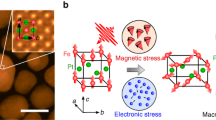Abstract
We have developed a new method for the determination of the anisotropy constant and saturation magnetization of magnetic nanoparticles. This method deals with the approximation of magnetization relaxation curves measured upon application and further fast switching off the dc magnetizing field. The relaxation process is registered in the time interval from 6 μs to several minutes by using a scanning high-T C SQUID-microscope equipped with a specially designed electronic circuit composed of a fast solid-state switch and a low-inductance magnetizing coil. The algorithm for calculating the approximation data is based on the activation Néel–Arrhenius law and takes into account the size distribution of the nanoparticles and the angular distribution of their easy axes. The performance of the method is demonstrated on dilute (∼0.2 vol%) ensembles of near-spherical Fe3O4 nanoparticles with a mean size of 7.7 nm and a standard deviation of 45% as determined from transmission electron microscopy data.











Similar content being viewed by others
References
Aharoni A (1996) Ferromagnetism. Oxford University Press, Oxford
Bacri J, Perzynski R, Salin D, Cabuil V, Massart R (1990) Ionic ferrofluids: a crossing of chemistry and physics. J Magn Magn Mater 85:27–32
Brown W (1963) Thermal fluctuations of a single-domain particle. Phys Rev 130:1677–1686
Caizer C (2003) Saturation magnetization of γ-Fe2O3 nanoparticles dispersed in a silica matrix. Physica B 327:27–33
Cannas C, Concas C, Falqui A, Gatteschi D, Musinu A, Piccaluga G, Sangregorio C, Spano G (2001) Superparamagnetic behavior of γ-Fe2O3 nanoparticles dispersed in a silica matrix. Phys Chem Chem Phys 3:832–838
Chikazumi S (1964) Physics of magnetism. Wiley, New York
Duarte EL, Itri R, Lima E, Baptista MS, Berquo TS, Goya GF (2006) Large magnetic anisotropy in ferrihydrite nanoparticles synthesized from reverse micelles. Nanotechnology 17:5549–5555
Fiorani D (ed) (2005) Surface effects in magnetic nanoparticles. Springer
Garcia-Otero J, Porto M, Rivas J, Bunde A (1999) Influence of the cubic anisotropy constants on the hysteresis loops of single-domain particles: a Monte Carlo study. J Appl Phys 85:2287–2292
Held GA, Grinstein G, Doyle H, Sun Sh, Murray C (2001) Competing interactions in dispersions of superparamagnetic nanoparticles. Phys Rev B 64:012408-1–012408-4
Jamet M, Wernsdorfer W, Thirion C, Mailly D, Dupuis V, Mélinon P, Pérez A (2001) Magnetic anisotropy of a single cobalt nanocluster. Phys Rev Lett 86:4676–4679
Kadau K, Gruner M, Entel P, Kreth M (2003) Modeling structural and magnetic phase transitions in iron-nickel nanoparticles. Phase Transit 76:355–365
Kodama R (1999) Magnetic nanoparticles. J Magn Magn Mater 200:359–372
Lin XM, Sorensen CM, Klabunde KJ, Hajipanayis GC (1999) Control of cobalt nanoparticle size by the germ-growth method in inverse micelle system: size-dependent magnetic properties. J Mater Res 14:1542–1547
Luis F, Petroff F, Torres JM, Garcia LM, Bartolome J, Carrey J, Vaures A (2002) Magnetic relaxation of interacting Co clusters: crossover from two- to three-dimensional lattices. Phys Rev Lett 88:217205-1–217205-4
McCallum RW (2005) Determination of the saturation magnetization, anisotropy field, mean field interaction, and switching field distribution for nanocrystalline hard magnets. J Magn Magn Mater 292:135–142
Moser A, Takano K, Margulies DT, Albrecht M, Sonobe Y, Ikeda Y, Sun Sh, Fullerton EE (2002) Magnetic recording: advancing into the future. J Phys D: Appl Phys 35:R157–R167
Mørup S (1990) Mossbauer effect in small particles. Hyperfine Interactions 60:959–974
Muxworthy AR, McClelland E (2000) Review of the low-temperature magnetic properties of magnetite from a rock magnetic perspective. Geophys J Int 140:101–114
Néel L (1949) Théorie du trainage magnétique. Ann Geophys 5:99
Néel L (1954) J Phys Radium 15:376
Osborn JA (1945) Demagnetizing factors of the general ellipsoid. Phys Rev 67:351–357
Pankhurst QA, Binns C, Maher M, Kechrakos D, Trohidou K (2002) Magnetic behavior of nanostructured films assembled from preformed Fe clusters embedded in Ag. Phys Rev B 66:184413-1–184413-12
Pankhurst QA, Connolly J, Jones SK, Dobson J (2003) Application of magnetic nanoparticles in biomedicine. J Phys D: Appl Phys 36:R167–R181
Poddar P, Telem-Shafir T, Fried T, Markovich G (2002) Dipolar interactions in two- and three-dimensional magnetic nanoparticle arrays. Phys Rev B 66:060403-1–060403-4
Si Sh, Li Ch, Wang X, Yu D, Peng Q, Li Y (2005) Magnetic monodisperse Fe3O4 nanoparticles. Cryst Growth Des 5:391–393
Song T, Roshko RM, Dahlberg E (2001) Modelling the irreversible response of magnetically ordered materials: a Preisach-based approach. J Phys: Condens Matter 13:3443–3460
Stoner E, Wohlfarth E (1991) A mechanism of magnetic hysteresis in heterogeneous alloys. IEEE Trans Magn 27:3475–3518 (reprinted from (1948) Philos Trans R Soc London A240:599–642).
Suess D, Schrefl T, Fidler J (2001) Reversal modes, thermal stability and exchange length in perpendicular recording media. IEEE Trans Magn 37:1664–1666
Vargas JM, Socolovsky LM, Knobel M, Zanchet D (2005) Dipolar interactions and size effects in powder samples of colloidal iron oxide nanoparticles. Nanotechnology 16: S285–S290
Volkov I, Chukharkin M, Snigirev O, Ranchinski M (2003) YBCO submicron Josephson junctions on bicrystal substrates. IEEE Trans Appl Supercond 13:861–864
Volkov IA, Chukharkin ML, Snigirev OV, Volkov AV, Moskvina MA, Gudoshnikov SA, Kerimov AK (2005) HTS SQUID microscopy for measuring the magnetization relaxation of magnetic nanoparticles. IEEE Trans Appl Supercond 15:3874–3878
Vonsovsky SV (1974) Magnetism. Wiley, New York
Weller D, Moser A (1999) Thermal effect limits in ultrahigh density magnetic recording. IEEE Trans Magn 35:4423–4439
Woods SI, Kirtley JR, Sun Sh, Koch RH (2001) Direct investigation of superparamagnetism in Co nanoparticle films. Phys Rev Lett 87:137205-1–137205-4
Zeng H, Li J, Liu JP, Wang ZL, Sun Sh (2002) Exchange-coupled nanocomposite magnets by nanoparticle self-assembly. Nature 420:395–398
Acknowledgements
This work was supported by the Russian Foundation for Basic Research under the projects # 06-02-16776-a and # 07-02-91227-YaF_a.
Author information
Authors and Affiliations
Corresponding author
Rights and permissions
About this article
Cite this article
Volkov, I., Chukharkin, M., Snigirev, O. et al. Determination of the anisotropy constant and saturation magnetization of magnetic nanoparticles from magnetization relaxation curves. J Nanopart Res 10, 487–497 (2008). https://doi.org/10.1007/s11051-007-9282-y
Received:
Accepted:
Published:
Issue Date:
DOI: https://doi.org/10.1007/s11051-007-9282-y




